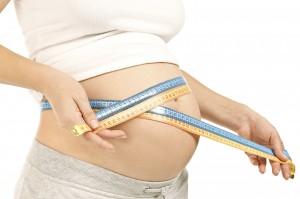
Women of average weight who become pregnant are told by their doctors that they should put on between 25 and 30 pounds by the end of their pregnancy. This weight is the combined weight of the baby, amniotic fluid and the placenta. But it also factors in a little extra fat that will accumulate around the mother’s waist and over her belly. This new fat will help nourish the fetus, especially in the third trimester, when it starts to grow a lot more.
A new study finds that the new fat that mothers-to-be put on during pregnancy also serves to protect the unborn infant from exposure to some highly toxic chemicals that have accumulated in the mother’s pre-pregnancy fat over the years.
If a pregnant woman doesn’t gain enough weight, she will lose some of her “old” fat as the fetus starts to need more nourishment. This pre-existing fat is much more likely to have in it diverse, toxic persistent organic pollutants, or POPs, which, despite their name, are man-made chemicals that have a tendency to get stored in fat cells. When this fat is burned, the POPs are released into the mother’s blood, thereby reaching the fetus through the placenta.
The use of some POPs has been banned in many countries, but not in all. And even in countries where bans are in place, POP contamination still exists there, as the chemicals travel long distances through the winds and the water cycle, and are eventually deposited in the soil.
POPs have been found in remote areas, including the Arctic — far from any place where the chemicals were originally released. Further, these pollutants can take a great many years to disappear from the environment; so, they are still found in places where bans have been in effect for decades.
There are three categories of POPs that are of concern to environmentalists and public health officials: Those found in some pesticides (including DDT, which was banned in the United States in 1972); certain industrial chemicals, including PCBs (polychlorinated biphenyls); and unintended by-products from the production of different POPs. (POP byproducts are also released when the following are burned: coal, peat, hospital waste, hazardous waste, municipal waste and vehicle emissions. Source: World Health Organization.)
PCBs, which you may have heard mentioned, have been used for a variety of industrial uses, including as fire retardants and in the making of plastics, oil-based paints and insulating materials. Manufacture of PCBs was banned in the U.S. in 1979, due to growing concerns over their apparent toxicity.
POPs, including PCBs, have been found to have varying degrees of toxicity to humans, unborn babies and ocean life. In the human uterus, exposure has been linked to serious adverse outcomes for the baby, including low birth weight, learning difficulties in the first years of life, hormonal changes and decreased immune function.
In the case of PCBs, these have also been determined to be carcinogenic, and to affect the immune, nervous and endocrine systems. However, the main route of exposure to PCBs is by eating large fish, in which the toxins accumulate over time. Concern over PCB contamination, as well as mercury released into the waterways from industrial sources, is the reason why doctors caution pregnant women to avoid eating bigger fish such as swordfish or shark, and to limit their consumption of small fish to no more than two servings a week.
In the above study, researchers from Spain’s University of Oviedo compared pregnancy weight gain in 325 women from Aviles, Spain, with the levels of 35 chemicals in their babies’ umbilical cord blood. Chemical levels in the cord blood decreased as the mother’s weight gain increased.
The difference was particularly noticeable in two chemicals: a byproduct of the insecticide lindane called beta-HCH, and a DDT metabolite, DDE. For every pound gained, cord blood readings fell 0.75 percent for DDE and 1.4 percent for beta-HCH; this represented a reduction of 22 percent in DDE level and 42 percent in beta-HCH level.
While 40 percent of the mothers had put on too much weight during their pregnancy, 25 percent had not gained enough weight.
The results of this study were published recently online in Environmental Health News.
By Jamell Andrews